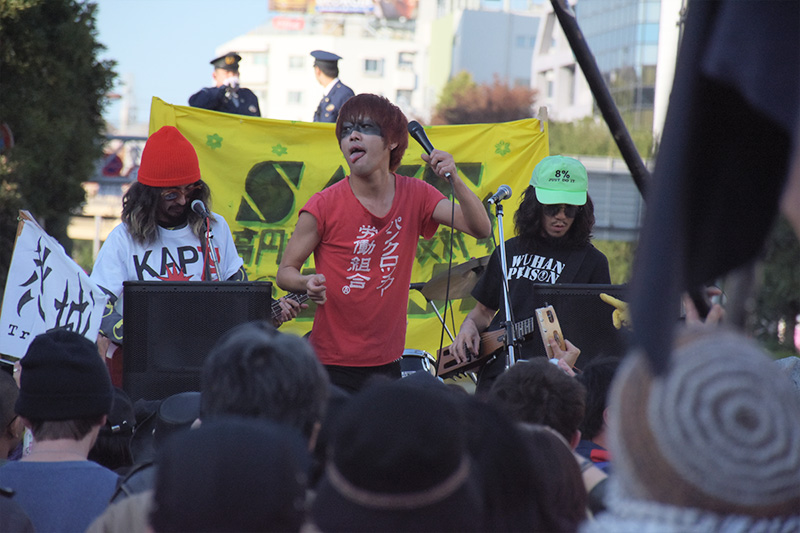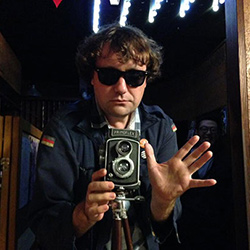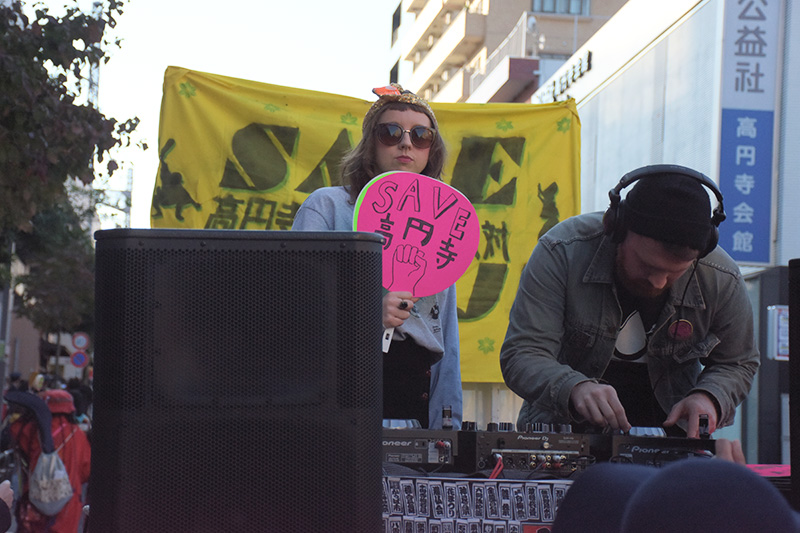MOST READ
- interview with xiexie オルタナティヴ・ロック・バンド、xiexie(シエシエ)が実現する夢物語
- Chip Wickham ──UKジャズ・シーンを支えるひとり、チップ・ウィッカムの日本独自企画盤が登場
- Natalie Beridze - Of Which One Knows | ナタリー・ベリツェ
- 『アンビエントへ、レアグルーヴからの回答』
- interview with Martin Terefe (London Brew) 『ビッチェズ・ブリュー』50周年を祝福するセッション | シャバカ・ハッチングス、ヌバイア・ガルシアら12名による白熱の再解釈
- VINYL GOES AROUND PRESSING ──国内4か所目となるアナログ・レコード・プレス工場が本格稼働、受注・生産を開始
- Loula Yorke - speak, thou vast and venerable head / Loula Yorke - Volta | ルーラ・ヨーク
- interview with Chip Wickham いかにも英国的なモダン・ジャズの労作 | サックス/フルート奏者チップ・ウィッカム、インタヴュー
- interview with salute ハウス・ミュージックはどんどん大きくなる | サルート、インタヴュー
- Kim Gordon and YoshimiO Duo ──キム・ゴードンとYoshimiOによるデュオ・ライヴが実現、山本精一も出演
- Actress - Statik | アクトレス
- Cornelius 30th Anniversary Set - @東京ガーデンシアター
- 小山田米呂
- R.I.P. Damo Suzuki 追悼:ダモ鈴木
- Black Decelerant - Reflections Vol 2: Black Decelerant | ブラック・ディセレラント
- Columns ♯7:雨降りだから(プリンスと)Pファンクでも勉強しよう
- Columns 6月のジャズ Jazz in June 2024
- Terry Riley ——テリー・ライリーの名作「In C」、誕生60年を迎え15年ぶりに演奏
- Mighty Ryeders ──レアグルーヴ史に名高いマイティ・ライダース、オリジナル7インチの発売を記念したTシャツが登場
- Adrian Sherwood presents Dub Sessions 2024 いつまでも見れると思うな、御大ホレス・アンディと偉大なるクリエイション・レベル、エイドリアン・シャーウッドが集結するダブの最強ナイト
Home > Columns > Politics > 音によるグラフィティ──高円寺の再開発反対デモから見えてきたもの
目に見えるよりも先に、音が聞こえてくる。穏やかな秋の日の午後、高円寺と阿佐ヶ谷のあいだにある青梅街道を、数百の人々が笑いあい、踊りながら、先導する何台かのトラックにつづいてゆっくりと進んでいく。そのなかの一台には何組かのバンド──ジャンルはパンクからレゲエ、ファンク、サイケデリック、ロックなど様々だ──が乗りこみ、他のトラックは過去の名曲を爆音でプレイするDJたちを乗せている。音は道沿いを前後に広がって、路地へと滲みだしていき、お祭り騒ぎをしながら道路の上を進んでいく小さな群衆がすぐ近くまで迫っていることを予告している。買い物客や通行人たちは、だんだんと近づいてくる音の壁をどこか楽しげに、興味深そうに眺めている。それが何のためのものなのかは誰にも分からない。だが音が近づいてくることは誰にでも分かる。
東京という街において音は、特定の空間を誰が所有しているかを定義し、その所有権を主張するさいの鍵となる役割を果たしている。たとえば人の往来がせわしない駅周辺のエリアは、数えきれない広告の音や、店の入り口からとつぜん漏れだしてくる四つ打ちの音、あるいははるか頭上の街頭ヴィジョンから聞こえてくる音でたえず溢れかえっている。結果として人は、そうした領域が商業と資本に属している場所であることを知らされることになるわけである。だが商業的な通りからほんの少し外れると、今度は住宅エリアに入っていくことになる──するととつぜん静けさが訪れ、屋内での音は、一軒家やアパートの薄い壁の外に漏れないように配慮されることになる。このルールが侵された場合、家主を呼ばれるか、警察の訪問を受けるはめになる。騒がしい隣人が歓迎されることはありえない。音楽が演奏されるのは基本的に、薄暗い地下の空間や、ビルの上層階など、防音のしっかりした場所に限定される。公共の場で音を出すことが許される場合があるとしてもそれは、ボリュームを抑えた路上パフォーマンスというかたちであったり、広告のBGMなど、商業的な目的をもったものとして以外にはありえないのである。
政治という場がおもしろいのは、日本の場合それが、音が社会的に定められた境界を侵犯していくことになる場だからだ。たとえば、期間中ずっと候補者の名前を叫びつづけ、住宅街のなかをゆっくりと走る選挙カーや、30年代の愛国的な軍歌を爆音で流して走る黒塗りの街宣車のことを考えてみればいい。ザ・クラッシュの“ロンドン・コーリング”の音に合わせ街頭で踊る抗議者たちによる、今回のお祭り騒ぎも同様である。こういった例のなかでは、人々の普段の暮らしのなかにある均衡を破り、別の何事かへと関心を向けされるために音が用いられているわけだ。

今回の高円寺の場合でいうなら、その参加者たちは、街の北側まで目抜き通りを拡大しようとするジェントリフィケーション計画にたいして異議申したてをおこなっているのだといえる。彼らは、街を二分し、小さな家を立ち退かせて、どこにでもあるような複合施設や不動産投資事業によって、近隣一帯の商店の活性化を目論む計画にたいして抗議しているわけである。とはいえ、話はそれだけで終わるものではない。突きつめていえば、街を練り歩き騒ぎを起こす数百人の人々はかならずしも、開発業者の連中や、役人たちや政治家たちの考えを変えようとしているわけではない。そういった者たちの決定を覆すための現実的な戦いは、裁判所や杉並区役所のなかでおこなわれることになるはずである。今回のデモがああいったかたちでおこなわれたのには、そういった現実的な理由とは別の理由があったはずなのだ。
ではじっさいのところ、今回のこの抗議はいったいなにを目指してデモをおこなっていたのだろうか。この問いにたいして答えようとおもうなら、そこで流れている音楽それじたいに注意を向けてみればいい。参加したミュージシャンやDJの多くは、高円寺のローカルな音楽シーンで活躍する者たちであり、デモの場で彼らは、普段は防音された室内でプレイしている曲を演奏していた。またこの抗議のオーガナイザーである素人の乱は、ふかく地域のコミュニティにかかわり、音楽シーンにもつよい繋がりをもつコレクティヴである。以上をふまえるなら、今回の抗議は、そこに参加した者たちそれじたいに向けられたものなのだといえるはずだ。つまりそれは、自分たちを互いに結びつけるための方法であり、一つのコミュニティとして、自分たちがいったいなにを目指しているのかを思いださせるための方法だったのである。
さらにいえばそれは、高円寺というローカルな場所だけにかかわるものでもなかった。この抗議は、広い意味での住環境の問題に関係する活動家たちによってサポートされたものでもあった。じっさい、昨年おこなわれた同様の抗議では、京都の吉田寮の追い出し問題〔訳註1〕にたいする抗議者たちや、香港からやってきた民主活動家を含む多様なグループの代表者たちがスピーチするすがたが見られている。今回の抗議と同様の音楽的な形式でおこなわれた2011年の反原発運動のときにも、ソウルのホンデ地区における反ジェントリフィケーション運動に参加する韓国のパンク活動家が参加していた。したがってこれらの抗議は、場所を問わずよりよいコミュニティを築こうとする者たちが互いに出会い、アイデアや共通の地平を確認しあうための祝祭としておこなわれたものでもあるのだ。
こうした抗議のなかにおける音楽は、なんらかのメッセージの媒介として機能しているわけではない。むしろ音楽はそこで、単純にそれが一番得意なことをしているだけなのである。つまりそれは、参加者たちのあいだにコミュニティの感覚が生じる手助けをしているのだ。音楽は、東京のいたるところにあるあの暗く狭い防音された部屋のなかで密かに、数メーター離れた場所で買い物し、働き、往来している人たちから隠れたまま、たえずそうした役割を果たしてきた。じっさい、音楽をきっかけにして出会った人間たちが、何十人と今回のデモの場に集まり、その場で自分たちのつながりを、つまり自分たちをパンクやインディー好きやノイズ狂いのコミュニティとして結びつけているつながりを、あらためて確認することになった。今回の高円寺のデモは、間違いなくこうした役割を果たしている。とはいえ、防音された薄暗いライヴ・ハウスのなかでも一つのコミュニティとして集まれるにもかかわらず、いったいなぜそれを街頭へと持ちだす必要があったのだろうか。
この記事の冒頭で私は、いかに音が公共空間にたいする所有権を誇示するための方法になっているかについてや、政治的な行動が、特定の問題にたいして人の注意を引くために、体制によって定められた空間の所有権を音を用いて侵犯したり、あるいはぼやかしたりする場合が多く見られることについて言及した。いうまでもなくそうした政治と音のかかわりは、今回のサウンド・デモのなかでも確認されたものである──外部の聴衆の必要性は、「身をもってなにかを示す」という方法にあらかじめ備わったものだといえる。だがそれだけではない。この抗議における音楽の用いられ方は、公共空間の所有権の問題だけでなく、同時にまた、コミュニティのあり方についての省察へと向けられたものでもあったのだ。
われわれは、商業的な領域が公共空間を支配するのを許し、その所有権を主張するのを許すことに、あまりにも慣れすぎてしまっている。たえずあらゆる角度からやってくる音と映像による広告の弾幕は、商業的なものや資本が、われわれの都市やローカルな場にたいして好き放題にふるまう権利を抵抗なく認めさせるための、致命的なプロパガンダとして機能している。だがそれにたいして、高円寺の通りに沿った音楽による抗議(や、数週間前の2019年10月におこなわれた渋谷から表参道へといたるプロテスト・レイヴのような最近の同様の出来事〔訳註2〕)は、一種の音によるグラフィティなのである。それはじっさいのグラフィティと同様、商業の側がもっぱら自分たちだけのものだと考えている空間にたいして、われわれじしんの所有権を主張するための方法として機能するものなのだ。それをとおしてわれわれは、防音された地下の部屋から飛びだしていくことになり、街頭は自分たちのものだと、大きな声ではっきりと主張することができるようになるのである。
*訳註2 DJの Mars 89 らの呼びかによって2019年10月29日におこなわれた路上レイヴ。「我々は自身の身体の存在を以て、この国を覆う現状に抵抗する」(ステートメントより)。以下のURLを参照。https://www.residentadvisor.net/events/1335758 (編註:Mars89 は『ele-king vol.25』のインタヴューでその動機や背景について語ってくれています)
You hear us before you see us. A couple of hundred people, laughing, dancing, slowly making their way down Ome-kaido between Koenji and Asagaya on a chilly autumn afternoon, led by a couple of trucks, one hosting a series of bands – punk, reggae, funk, psychedelia, rock – and another carrying DJs blasting out celebratory anthems from ages past. The sound carries down the road ahead and behind, bleeding down sidestreets, heralding the passing of the small crowd of marching revellers. Shoppers and passers-by peer towards the advancing wall of sound, amused, curious. No one really knows what it’s for, but everyone knows we’re coming.
In Tokyo, sound plays a key role in defining and asserting ownership over particular spaces. The area around a busy station explodes with the sounds of a thousand adverts, jingles blasting from shop doorways and booming down from towering video displays. In this way, we know the territory belongs to commerce and capital. Step away from these commercial streets just a short few steps, though, and you may find yourself in a residential area – suddenly silent, domestic noises diligently suppressed within the thin walls of houses and apartments. Transgressions here are greeted with calls to the landlord or visits from the cops. No one likes a noisy neighbour. Music is typically confined to its own designated spots: dingy, carefully soundproofed boxes in the basements or upper floors of buildings. Where it is allowed out into public spaces, it does so either in the form of volume-suppressed street performances or as the servant of commerce, soundtracking adverts.
Politics is interesting because it is a sphere of Japanese life where sound transgresses its socially designated limits. The sound trucks that crawl around your neighbourhood, screaming out the names of politicians endlessly during election periods. The black vans blasting out patriotic military songs from the 1930s. The carnival of protesters dancing down the street in Koenji to the sound of “London Calling” by The Clash. All these people are using sound to disrupt the equilibrium of people’s daily lives and draw their attention to something else.
In the case of the Koenji marchers, we are protesting gentrification in the form of plans to extend a main road up through the north of the town, splitting the neighbourhood in two, and replacing small houses and bustling neighbourhood shops with generic condo complexes and real estate investment projects. That’s not all we’re doing, though. After all, a couple of hundred people marching around and making a noise aren’t going to make a bunch of developers, civil servants and politicians change their minds. The real fight against these proposals is going to happen in the courts and in Suginami City Office. There must be another reason why this march is happening and in this form.
Who is this protest march for? One way to answer this is to look at the music itself. A lot of the musicians and DJs are people involved in the local Koenji music scene, playing the music they always play, locked away in their little soundproofed boxes. The protest’s organisers, the Shiroto no Ran collective, are deeply embedded in the local community, and have strong links with the music scene. In this sense, the protest is for its own participants: a way of bringing us together and reminding us of what we stand for as a community.
It’s not just about the local area though. Also supporting the protest were activists who are engaged more broadly with environmental issues. A similar protest last year brought in speakers representing groups as diverse as the Yoshida Dormitory protests in Kyoto and pro-democracy activists from Hong Kong. The 2011 anti-nuclear protests, which kicked off in Koenji with a very similar musical format, also incorporated South Korean punk activists who were involved in anti-gentrification protests in Seoul’s Hongdae area. These kinds of protests, then, are also festivals for the meeting and sharing of ideas and common ground between those looking to build better communities everywhere.
Music in this protest is not functioning as a vehicle for a particular message in itself, but rather to simply do what it does best: to be a facilitator for a sense of community among participants. This is what music does all the time in those small, dark, soundproofed boxes all around Tokyo, locked away and hidden from the daily lives of people shopping, working and walking just a few metres away. A few dozen of us gather, joined by music, and reaffirm the links between us that make us a community of punks, indie kids, noiseniks or whatever. So the Koenji march is doing this, yes, but if we can come together as a community in a dingy soundproofed live venue, why do we need to take it out into the streets?
At the beginning of this article, I talked about how sound is a way of marking ownership over various public spaces, and how politics often behaves in ways that transgress or blur those established patterns of ownership in order to draw attention to one issue or another. Of course, that’s part of what we’re doing with this musical march – after all, the need for an external audience is inherent in the word “demonstration”. More than that, though, I think the use of music in this protest is where the issues of community consolidation and ownership of public space come together.
We are too comfortable in allowing the commercial sphere to dominate and assert its ownership over public space. The constant barrage of advertising coming at us from all angles in sound and vision functions as a deadening sort of propaganda that makes us too easily accept commerce and capital’s right to do whatever it wants with our cities and neighbourhoods. However, just as graffiti can function as a way of asserting citizens’ ownership over spaces that commerce thinks of as uniquely its territory, musical protests along the lines of the Koenji march (and similar recent events like the Shibuya/Omotesando protest rave a couple of weeks previously on October 2019) are a kind of sonic graffiti in which we can come out of our soundproofed underground boxes and say loudly that these streets are ours.
Profile
 Ian F. Martin
Ian F. MartinAuthor of Quit Your Band! Musical Notes from the Japanese Underground(邦題:バンドやめようぜ!). Born in the UK and now lives in Tokyo where he works as a writer and runs Call And Response Records (callandresponse.tictail.com).
COLUMNS
- Columns
スティーヴ・アルビニが密かに私の世界を変えた理由 - Columns
6月のジャズ- Jazz in June 2024 - Columns
♯7:雨降りだから(プリンスと)Pファンクでも勉強しよう - Columns
5月のジャズ- Jazz in May 2024 - Columns
E-JIMAと訪れたブリストル記 2024 - Columns
Kamasi Washington- 愛から広がる壮大なるジャズ絵巻 - Columns
♯6:ファッション・リーダーとしてのパティ・スミスとマイルス・デイヴィス - Columns
4月のジャズ- Jazz in April 2024 - Columns
♯5:いまブルース・スプリングスティーンを聴く - Columns
3月のジャズ- Jazz in March 2024 - Columns
ジョンへの追悼から自らの出発へと連なる、1971年アリス・コルトレーンの奇跡のライヴ- Alice Coltrane - Columns
♯4:いまになって『情報の歴史21』を読みながら - Columns
攻めの姿勢を見せるスクエアプッシャー- ──4年ぶりの新作『Dostrotime』を聴いて - Columns
2月のジャズ- Jazz in February 2024 - Columns
♯3:ピッチフォーク買収騒ぎについて - Columns
早世のピアニスト、オースティン・ペラルタ生前最後のアルバムが蘇る- ──ここから〈ブレインフィーダー〉のジャズ路線ははじまった - Columns
♯2:誰がために音楽は鳴る - Columns
『男が男を解放するために』刊行記念対談 - Columns
1月のジャズ- Jazz in January 2024 - 音楽学のホットな異論
第2回目:テイラー・スウィフト考 - ――自分の頭で考えることをうながす優しいリマインダー


 DOMMUNE
DOMMUNE